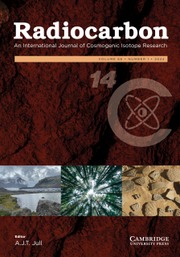No CrossRef data available.
Article contents
Tracing the source of dissolved organic carbon in rivers by carbon isotope (Δ14C-δ13C): A case study of Tianyu River in Qinling Mountains, China
Published online by Cambridge University Press: 21 August 2025
Abstract
The cycling of carbon in riverine systems is a critical component of global carbon cycle research. However, the sources and performances of riverine carbon in the Qinling Mountains, a pivotal hydrological nexus in China, remain poorly understood. This study investigates the seasonal variations of dissolved organic carbon (DOC) concentration in the Tianyu River within the Qinling Mountains. By utilizing a combination of carbon isotopic signatures (Δ14C-δ13C) and the stepped-combustion method, we examined the sources of DOC and the contribution ratio of each end-member. Our findings reveal that: (1) the concentrations and dual carbon isotope ratios of DOC in the Tianyu River are influenced by regional climatic factors, exhibiting distinct seasonal patterns; (2) the 14C age of DOC in the Tianyu River is comparatively older than the global average for rivers but younger than that of China’s three major rivers (the Yellow, Yangtze, and Pearl Rivers); and (3) the DOC mainly comes from exogenous sources, with a proportion of about 85.8%–88.4%. Vegetation and riverine sediments are identified as primary contributors. These findings suggest that exemplary ecological preservation exists within the Qinling region while operating within an efficient carbon cycling system. This investigation provides initial insights into how regional climatic conditions influence riverine carbon cycles and enhances our understanding of biogeochemical processes related to carbon.
Information
- Type
- Research Article
- Information
- Copyright
- © The Author(s), 2025. Published by Cambridge University Press on behalf of University of Arizona
Footnotes
Both authors contribute equally to this work.


